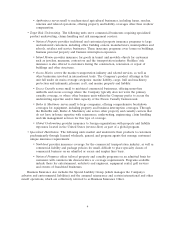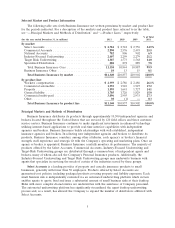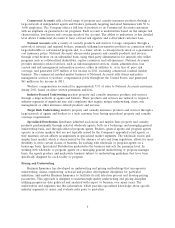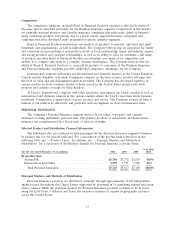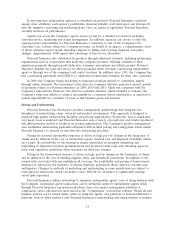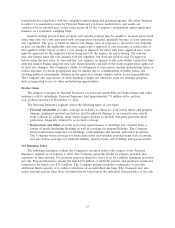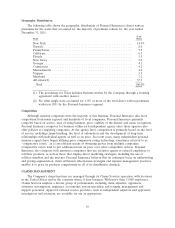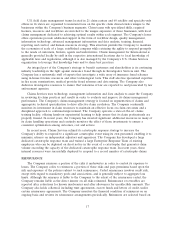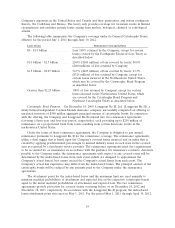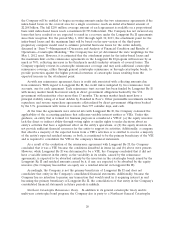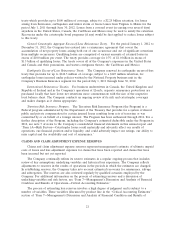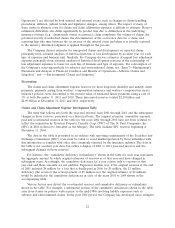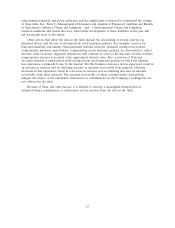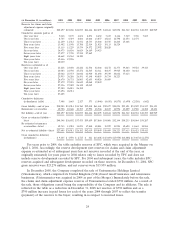Travelers 2011 Annual Report Download - page 26
Download and view the complete annual report
Please find page 26 of the 2011 Travelers annual report below. You can navigate through the pages in the report by either clicking on the pages listed below, or by using the keyword search tool below to find specific information within the annual report.In selecting new independent agencies to distribute its products, Personal Insurance considers,
among other attributes, each agency’s profitability, financial stability, staff experience and strategic fit
with the segment’s operating and marketing plans. Once an agency is appointed, Personal Insurance
carefully monitors its performance.
Agents can access the Company’s agency service portal for a number of resources including
customer service, marketing and claims management. In addition, agencies can choose to shift the
ongoing service responsibility for Personal Insurance’s customers to one of the Company’s five
Customer Care Centers, where the Company provides, on behalf of an agency, a comprehensive array
of direct customer service needs, including response to billing and coverage inquiries, and policy
changes. Approximately 1,900 agents take advantage of this service alternative.
Personal Insurance also distributes its products through additional channels, including sponsoring
organizations such as corporations that make the company’s product offerings available to their
employees primarily through payroll deduction, consumer associations and affinity groups. Personal
Insurance handles the sales and service for these programs either through a sponsoring independent
agent or through two of the company’s call center locations. In addition, since 1995, the Company has
had a marketing agreement with GEICO to underwrite homeowners business for their auto customers.
In 2009, the Company began marketing its insurance products directly to consumers, largely
through online channels. The investment in the direct-to-consumer initiative generated modest growth
in premium volume for Personal Insurance in 2009, 2010 and 2011, which was consistent with the
Company’s expectations. However, the direct-to-consumer initiative, while intended to enhance the
Company’s long-term ability to compete successfully in a consumer-driven marketplace, is expected to
remain unprofitable for a number of years as this business grows and matures.
Pricing and Underwriting
Personal Insurance has developed a product management methodology that integrates the
disciplines of underwriting, claim, actuarial and product development. This approach is designed to
maintain high quality underwriting discipline and pricing segmentation. Proprietary data accumulated
over many years is analyzed, and Personal Insurance uses a variety of proprietary and vendor produced
risk differentiation models to facilitate its pricing segmentation. The Company’s product management
area establishes underwriting guidelines integrated with its filed pricing and rating plans, which enable
Personal Insurance to execute its risk selection and pricing processes.
Pricing for personal automobile insurance is driven in large part by changes in the frequency of
claims and by inflation in the cost of automobile repairs, medical care and litigation of liability claims.
As a result, the profitability of the business is largely dependent on promptly identifying and
responding to disparities between premium levels and projected claim costs, and obtaining approval
from state regulatory authorities when necessary for filed rate changes.
Pricing in the homeowners business is driven in large part by changes in the frequency of claims
and by inflation in the cost of building supplies, labor and household possessions. In addition to the
normal risks associated with any multiple peril coverage, the profitability and pricing of homeowners
insurance is affected by the incidence of natural disasters, particularly those related to weather and
earthquakes. Changes to methods of marketing and underwriting in some jurisdictions are subject to
state-imposed restrictions, which can make it more difficult for an insurer to significantly manage
catastrophe exposures.
Personal Insurance utilizes technology to maximize independent agents’ ease of doing business with
the Company. Automated quote transactions can be submitted online by independent agents either
through Personal Insurance’s proprietary platform, their own agency management platform or
comparative raters (discussed in more detail in the ‘‘Competition’’ section that follows). Nearly all new
business policies can be issued online either by using the agents’ own platform or Personal Insurance’s
platform, both of which interface with Personal Insurance’s underwriting and rating systems to monitor
14


